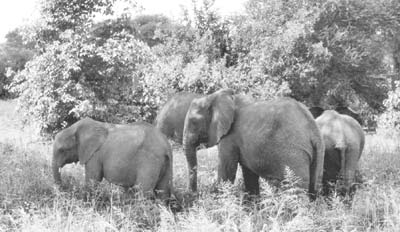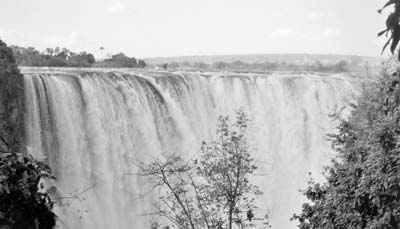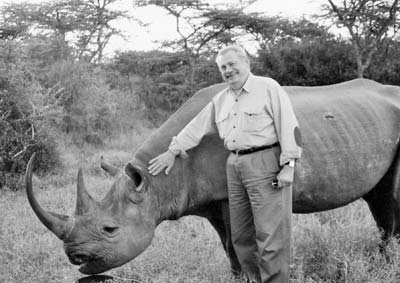Impressed with a 6-country tour of East Africa
by Claus Hirsch, New York, NY
In late March ’06 I embarked on my first trip to Africa. It was the start of a 3½-week vacation like no other I had ever taken.
Dispelling misconceptions
Many impressions are embedded in my mind after visiting six countries in East Africa. Three of those visits, admittedly, were very brief, but they do count toward my goal of visiting a total of 100 countries.
I traveled with Overseas Adventure Travel (800/493-6824, www.oattravel.com) of Cambridge, Massachusetts. Having received personal recommendations about them from other frequent travelers helped in the selection process. So did the fact that this outfit limits their tour groups to only 16 people.
The strongest impression that I am left with following my trip is that it is perfectly safe to travel to a lot of places that the State Department expresses qualms about — and that inexperienced travelers might think are inhabited by villains and robbers lurking behind every lamppost.
In the countries I visited, that simply wasn’t the case. If anything, I was very surprised and pleased by the friendly gestures we received from perfect strangers in Africa.
Kenya
Our group of 11 (plus one local leader from Kenya and two safari drivers/guides) began our journey with six days in Kenya, including a day at The Stanley Hotel in the capital city of Nairobi and several game drives.
The city itself — with traces of its colonial past — is fairly modern, but I saw neither McDonald’s nor any Chinese restaurants. What I did see, outside the city, were herds of elephants, zebras, Cape buffalos, many hyenas and baboons and various exotic birds.
We spent several days in a “tented lodge” and the experience exceeded my expectations. It was a far cry from the pup tents I slept in while in the army. These tents were six to seven feet high and had electricity, showers, ceiling fans, indoor toilets and mosquito netting in addition to pretty comfortable beds.
Among the places we visited in Kenya were the Karen Blixen house/museum, where the Danish baroness/writer (“Out of Africa”), also known as Isak Dinesen, lived from 1914 to 1931; a giraffe center, where one could feed the beasts from an elevated platform, and a chimpanzee sanctuary founded by Jane Goodall which housed several dozen chimps rescued from various African countries where they had been abused for years.
Tanzania
Next, we spent 11 days in Tanzania, staying in several different tented lodges and hotels. Generally, we found the countryside to be greener than in Kenya and the roads somewhat better — some even had painted center lines and posted speed limits!
While in Tanzania we visited Tarangire National Park, Manyara National Park and Ngorongoro Crater. At Ngorongoro we saw an amazing array of wildlife, including the usual herds of zebras and elephants plus lions, wildebeest, Cape buffalos, Thomson’s gazelles, impalas, baboons, etc.
We also stopped at Olduvai Gorge, where Louis and Mary Leakey made their historic fossil discoveries (not much to see except for a fairly primitive small museum) and spent time in the incomparable Serengeti National Park, where one can see hundreds of thousands of wildebeest and many other species of wildlife.
South Africa
After the completion of our Tanzania stay, half of the group headed back to the States while five of us went on to Zimbabwe for a post-trip adventure. We spent one day in Johannesburg (aka Joburg) en route and spent a wonderful night at the Afrika Lodge, run by a hospitable young retired colonel from the South African Air Force.
The others in my group opted for a lazy day at the lodge while I went on a guided tour of Soweto, the historic slum area of the city where the African freedom movement started. We visited some of the small shacks there, as well as the Nelson Mandela Museum and Mandela’s small original home. Most of it was quite depressing, although one young Scotsman I talked to maintained that conditions in Soweto were pretty good compared with what he had seen in New Delhi.
South Africa’s economy is years ahead of those of other African countries, and this was evident in the paved 8-lane highways in Joburg, the fine residential developments in and around the city (many with 24-hour armed guard service) and the highrise buildings in the downtown area. I want to go back to this country to see Cape Town, which everyone tells me is beautiful, and Kruger National Park.
Zimbabwe
The former Southern Rhodesia gets mostly bad press these days because of the policies of President Robert Mugabe, but we encountered no problems and felt quite safe.
The big feature here is Victoria Falls, and we stayed in the town of Victoria in one of the several fine hotels located there. In our case, it was the Ilala Lodge, which had good rooms, fine dining (I ate some delicious warthog there) and tasteful decorations highlighting the importance of explorers like David Livingstone.
The waterfall itself is very impressive, although one cannot always see it clearly because of the mist. In some areas, visitors get drenched walking close by.
In my opinion, Iguazú Falls, between Brazil and Argentina, is actually more impressive viewed from the ground, but one would be foolish not to spend the $85 required for a 10-minute helicopter ride above Victoria Falls. That really does the site justice!
From Victoria Falls, travelers can take side trips to several nearby countries or take a sunset boat trip on the Zambezi River (where we saw hippos frolicking and elephants swimming). I opted for a morning tour of next-door Zambia, where we visited the Livingstone Museum, an excellent small facility where one can view original letters written by the explorer/churchman, as well as the rather dismal town of Livingstone.
On another day, I took a tour of nearby Botswana for a game drive in Chobe National Park and a 2-hour cruise on the Chobe River to see elephants mud bathing and crocodiles at close range.
The food
The food we ate in most of the countries we visited was quite good although certainly not of French haute cuisine quality. Good soups (celery, potato, tomato, pumpkin, etc.) were always served at lunch and dinner, as were rice, potatoes, chicken, meat and local fish like tilapia. There was always good tropical fruit available plus various desserts.
Kenya, Tanzania and Zimbabwe all have decent local beers, and Zimbabwe, to my surprise, also produces wine — some of which was drinkable and some of which was truly horrible (e.g., something called “pinotage”).
Money matters
All of the countries we visited count heavily on the benefits of tourism. They have caught on to the importance of tipping, and U.S. greenbacks are welcome. If you visit, carry a large supply of one-dollar bills for both tipping and buying trinkets.
The locals often prefer dollars to their own currencies, but there are times when businesses give a clearly bad exchange rate when taking dollars. There are also times when local merchants have the audacity to charge a 5% premium for credit card purchases. Some also are reluctant to accept travelers’ checks.
Bargaining is an accepted way of doing business in Africa, just as it is in much of Asia and the Middle East. Merchants expect to bargain and will often give an opening price that is at least three times the final price they expect to get. I have seen many American travelers fail to learn this lesson and spend money foolishly.
Summing up
I’m very glad I made this visit and would recommend it to anyone with an open mind and a spirit of adventure. Safety was never an issue, and the presence of mosquitoes and other insects was surprisingly tame. Considering we were always at or near the equator, temperatures also were surprisingly mild most of the time.
I paid a total of $7,900 for my trip, which included my Kenya and Tanzania tour ($4,995), a post-trip extension to Zimbabwe ($1,295), single supplements and international round-trip airfare from JFK, plus all lodging, meals and park entrance fees.




